Written by Gabriel Serrano Denis
As the old guard of genre filmmakers once laid bare the fears and anxieties they lived and grew up with to create many of the classics we now cherish, so too is the younger generation gracing horror screens today with the experiences and traumas that marked them. None, however, is so especially attuned to their time and place as writer/director and editor Jane Schoenbrunwho’s 2021 creepypasta-inflected gem We’re All Going To The World’s Fair not only commented on internet-grown horror but also offered a disturbing glimpse into a teenager’s emotional isolation. In their 2021 film, the internet is both a comfort and a last resort, a desperate cry for attention that yields an unusual connection. Schoenbrun’s new film I Saw The TV Glow explores a similar need for connection, a strange television show called “The Pink Opaque” being the catalyst that brings together two lonely souls in 90s suburbia. In a fever dream style reminiscent of David Lynch mixed with Gus Van SantSchoenbrun brings to life a beautifully surreal coming of age tale where horror fiction makes more sense than the reality we’re subjected to.

I Saw The TV Glow brings many influences to mind as it unravels, almost functioning as worldbuilding by way of nostalgia. This world is both recognizable and eerily off, as if we’ve been transported to Twin Peaks (Lynch’s seminal 90’s TV show) while the story focuses on the characters’ internal journeys rather than a complicated murder mystery. The journey itself is that of Owen (played by Ian Foreman in his younger years and Justice Smith later on), a shy and reclusive teenager who meets TV-show obsessed 9th grader Maddy (Brigette Lundy-Paine). The TV show in question, “The Pink Opaque,” is an odd supernatural young adult show with surprisingly shocking and eerie horror elements that seem to be too extreme for its intended audience.
Although Owen can’t watch the show regularly due to strict curfews imposed by his parents, Maddy videotapes the show for him to view and keeps him up to speed with the lore and important plot points, all while navigating the painful reality of her everyday life . As Owen endures life with a detached and strict father and his mother’s terminal illness, he finds solace by sharing in Maddy’s obsession with her, which is until she suddenly and mysteriously disappears. Years later, Owen is drawn back into “The Pink Opaque” as the show’s plot begins to bleed into his past and present reality.
With We’re All Going To The World’s Fair, Jane Schoenbrun presented us with an uncomfortable and detailed view of a teenager spiraling down through an online roleplaying game, giving us insight into her psyche through her self-made videos and those of other players. It was a sort of hybrid of found footage and carefully constructed dramatic scenes that was never gimmicky or exploitative. in I Saw The TV Glow, they approach the story in a much more simple way, bar Owen’s fourth-wall breaking narration and elliptical nature. Narrative inventiveness here is supplanted by a striking, distinct visual style that calls back to 90s high-contrast cinematography and bold use of colors. Schoenbrun possesses a unique style that explodes on the screen in a burst of influences that range from early-90s TV and music videos, grungy indie filmmaking, and DIY horror of years past. With the help of Eric K. Yue‘s moody cinematography they achieve the tough balancing act of maintaining a dreadful atmosphere and imbuing it with poetic passages of genuine teenage angst and alienation. The film is caked with nostalgia but it never feels like its characters are living in the past.

Many will debate just how much of a horror film I Saw The TV Glow is but, although it clearly falls more in the “uncategorizable” realm, horror is as much the backbone of the film’s narrative as it is embedded in its visual fabric. “The Pink Opaque” show itself is disturbingly creepy, shot in the analog 90s aesthetic of classic kid’s horror shows like Are You Afraid of the Dark? and Goosebumps and boasting uncanny practical effects mixed with modern CGI. While the happenings in the “real” narrative between Owen and Maddy are not as scary as what happens in “The Pink Opaque”, as the show begins to mirror their reality a sense of dread permeates the narrative with Schoenbrun making full use of it to dig deeper into the psychological and tragic inner lives of teenagers in a period of transformation and even potential rebellion. The true horror Schoenbrun is reaching for is that of the insecurity and loneliness present in these teens’ lives, and the terrifying realization that there might be no escape from it. The creepy “monsters of the week” from “The Pink Opaque”, though only seen briefly, mostly act as distorted representations of Owen’s and Maddy’s fears, creatures that bask in the emotional suffering and traumas of their enemies. Without spoiling much, “The Pink Opaque’s” big bad Mr. Melancholy is a particular brand of nightmare fuel in the vein of the infamous Ghastly Grinner from Are You Afraig of the Dark? Schoenbrun is unafraid of exploring uncomfortable and challenging themes of urban isolation and emotional abuse, bringing their love of horror and the weird into a story that pits the hope of escape with the tragic comfort of sameness.
In a fair world, genre actors would receive more recognition, and Justice Smith here further justifies why the most poignant and meaningful performances can be found in horror today. Smith beautifully conveys Owen’s awkwardness in precise movements and detailed mannerisms, making brilliant use of his voice as well to communicate his social anxiety. He portrays Owen as a fragile and scared young man who can’t adequately express his need to break free of his reality, which is at the core of this frighteningly beautiful film.
Brigette Lundy-Paine equally paints the film with her awkward and strange mood as Maddy. Their deadpan and almost expressionless performance clearly portrays a character that has had enough of reality and who’s only respite can come in the form of escape. What would otherwise be secondary characters in a teen movie, like Gus Van Sant’s focus on ostracized youths, Jane Schoenbrun brings these alienated teens front and center. Relatability is not what Schoenbrun is going for, but rather an understanding of the trials of finding oneself in the mess of life when life itself seems to be against you.

Schoenbrun’s talent of capturing the essence of a specific moment in life, of the moment a teenager finds (or doesn’t) the path they’ll want to follow to justify existence in this world, is no small feat. The sights, the atmosphere, the music (perfectly curated by Schoenburn and including tracks featuring Phoebe Bridgers, King Womanand Caroline Polachekwith covers of 90s and early 2000’s mainstays Smashing Pumpkins and Broken Social Scene) all point toward an understanding of the paralyzing and controlling nature of a conformist society. It also embraces with open arms those who found themselves not in the conventional and spiritual sense, but rather through the fiction and pop culture that introduced new worlds and concepts to share with others. It all moves with the grace of an analog-induced dream, with the jagged edges of horror cinema cutting through the veins of introspective indie filmmaking. I Saw The TV Glow is a rallying cry against conformity in the form of horror poetry.


